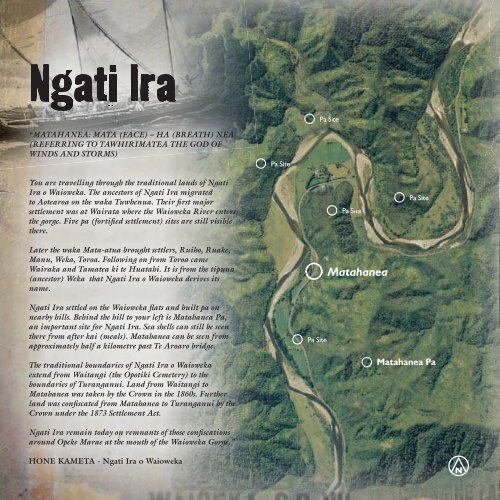The Waioeka Journey brochure - Department of Conservation
The Waioeka Journey brochure - Department of Conservation
The Waioeka Journey brochure - Department of Conservation
You also want an ePaper? Increase the reach of your titles
YUMPU automatically turns print PDFs into web optimized ePapers that Google loves.
“MATAHANEA: MATA (FACE) – HA (BREATH) NEA<br />
(REFERRING TO TAWHIRIMATEA THE GOD OF<br />
WINDS AND STORMS)<br />
You are travelling through the traditional lands <strong>of</strong> Ngati<br />
Ira o Waioweka. <strong>The</strong> ancestors <strong>of</strong> Ngati Ira migrated<br />
to Aotearoa on the waka Tuwhenua. <strong>The</strong>ir fi rst major<br />
settlement was at Wairata where the Waioweka River enters<br />
the gorge. Five pa (fortifi ed settlement) sites are still visible<br />
there.<br />
Later the waka Mata-atua brought settlers, Ruiho, Ruake,<br />
Manu, Weka, Toroa. Following on from Toroa came<br />
Wairaka and Tamatea ki te Huatahi. It is from the tipuna<br />
(ancestor) Weka that Ngati Ira o Waioweka derives its<br />
name.<br />
Ngati Ira settled on the Waioweka fl ats and built pa on<br />
nearby hills. Behind the hill to your left is Matahanea Pa,<br />
an important site for Ngati Ira. Sea shells can still be seen<br />
there from after kai (meals). Matahanea can be seen from<br />
approximately half a kilometre past Te Aroaro bridge.<br />
<strong>The</strong> traditional boundaries <strong>of</strong> Ngati Ira o Waioweka<br />
extend from Waitangi (the Opotiki Cemetery) to the<br />
boundaries <strong>of</strong> Turanganui. Land from Waitangi to<br />
Matahanea was taken by the Crown in the 1860s. Further<br />
land was confi scated from Matahanea to Turanganui by the<br />
Crown under the 1873 Settlement Act.<br />
Ngati Ira remain today on remnants <strong>of</strong> those confi scations<br />
around Opeke Marae at the mouth <strong>of</strong> the Waioweka Gorge.”<br />
HONE KAMETA - Ngati Ira o Waioweka<br />
Pa Site<br />
Pa Site<br />
Pa Site<br />
Pa Site<br />
Matahanea<br />
Pa Site<br />
Matahanea Pa<br />
“TAURANGA: TAU(ARRIVE) RANGA (ALIGHT)<br />
A recognised landing and resting place <strong>of</strong> waka on the Waioweka River.<br />
Rivers were the main means <strong>of</strong> travelling in those times past.” HONE KAMETA – Ngati Ira o Waioweka<br />
Haere Mai – Welcome to the Tauranga Valley<br />
entrance on the <strong>Waioeka</strong> <strong>Journey</strong>.<br />
On this part <strong>of</strong> the journey you can explore the Tauranga Valley<br />
where settlers tried and failed to farm the land. To reach the valley<br />
you will cross the nationally signifi cant historic Tauranga Bridge.<br />
Families, farmers, engineers and builders took up the challenge to<br />
settle and provide access to this valley.<br />
“…the grass was bought in Gisborne, sent by steamer to Auckland,<br />
sent back to Opotiki by small coastal boat, then carted by dray as far<br />
as possible, then by pack horse the rest <strong>of</strong> the journey.”<br />
MARY ANN ENSOR – Started bush farming<br />
with her husband in the <strong>Waioeka</strong> Gorge – 1905

















